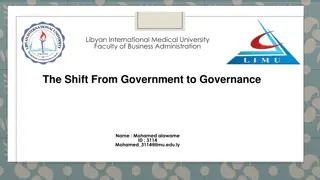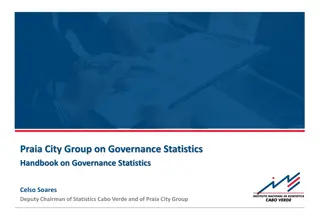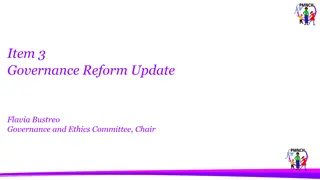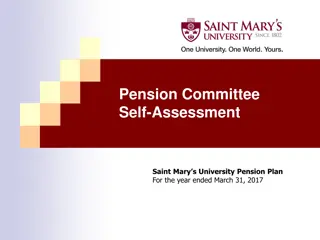Importance of Risk Management in Charity Governance
Effective risk management is crucial for charities to ensure known risks are monitored, decisions are informed, opportunities are maximized with confidence, strategic planning is enhanced, and aims are successfully achieved. The process involves identifying, assessing, evaluating, and monitoring risks across various categories like governance, operational, financial, external, and compliance risks.
Uploaded on Sep 20, 2024 | 0 Views
Download Presentation

Please find below an Image/Link to download the presentation.
The content on the website is provided AS IS for your information and personal use only. It may not be sold, licensed, or shared on other websites without obtaining consent from the author. Download presentation by click this link. If you encounter any issues during the download, it is possible that the publisher has removed the file from their server.
E N D
Presentation Transcript
Why does the Charity Commission say risk management is important? Identifying and managing the possible and probable risks that a charity may face over its working life is a key part of effective governance for charities of all sizes By managing risk effectively, trustees can help ensure that: significant risks are known and monitored, enabling trustees to make informed decisions and take timely action the charity makes the most of opportunities and develops them with the confidence that any risks will be managed forward and strategic planning are improved the charity s aims are achieved more successfully
Risk management model Typical stages in the management of risk are: 1. Identifying risks 2. Assessing risks 3. Evaluating what action needs to be taken on risks. 4. Developing a risk register 5. Periodic monitoring and assessment
1. Identifying risks A useful way to identify the risks an organisation may face is to look at risks in different categories. Suggested categories include: Governance Operational risk Finance risk Environmental and external risk Law and regulation compliance risk
1. Identifying risks Risk category Examples Governance risks inappropriate organisational structure trustee body lacks relevant skills or commitment conflicts of interest Operational risks lack of beneficiary welfare or safety poor pricing doubt about security of assets Financial risks inaccurate and/or insufficient financial information inadequate reserves and cash flow insufficient insurance cover External risks poor public perception and reputation demographic changes such as an increase in the size of beneficiary group changing government policy Compliance with law and regulation acting in breach of trust poor knowledge of the legal responsibilities of an employer poor knowledge of regulatory requirements of particular activities
2. Assessing risks Look at each identified risk and consider both: the impact if the risk occurs, and the likelihood of the risk occurring. This enables the trustees to identify those risks that fall into the major risk category.
3. Evaluating what action needs to be taken on risks Where major risks are identified, the trustees will need to make sure that appropriate action is being taken to manage them. For each of the major risks identified, trustees will need to consider any additional action that needs to be taken to manage the risk, either by lessening the likelihood of the event occurring, or lessening its impact if it does. Possible actions may include: the risk may need to be avoided by ending that activity the risk could be shared with others (eg a joint venture project) the risk can be reduced or eliminated by establishing or improving control procedures the risk may be accepted as being unlikely to occur and/or of low impact and therefore will just be reviewed annually
4. Developing a risk register A risk register draws together the key information for the highest priority risks: clear identification of the risk consequences of that risk becoming a reality action required to manage the risk describe the controls already in place further action required, identifying the timescale and responsibility for the action
4. Developing a risk register An example of a page in a risk register may look something like this: Risk Insufficient income from room hire to cover expenditure in the year Consequences Need to use reserves/savings to cover short fall Take out a loan Cease operation Existing controls in place Review accounts at end of year Appropriate controls to manage the risk Annual budget set to ensure charging enough to cover expenditure Monitor income and expenditure at each trustee meeting Further actions necessary Schedule regular reviews of financial position at trustee meetings and present regular updates Who Treasurer Timescale Urgent Calculate and implement an increase in room hire charges Treasurer/Booking secretary Urgent Plan and hold additional fundraising events Secretary & volunteers Medium term
5. Periodic monitoring and assessment Regularly reviewing risk will ensure that the trustees and management are aware of the current risks facing the charity. The risks will change over time, as will the extent of exposure to them. Reviewing risks will usually be an annual process but in periods of change it may be useful to review risks more frequently.
Benefits of the risk assessment processes A structured way of dealing with current and future risks The organisation can learn from mistakes and take advantage of opportunities Decision-making and actions can focus on the priority issues for the organisation
Useful links Charity Commission: CC26 Charities and risk management https://www.gov.uk/government/publications/charities-and-risk-management- cc26/charities-and-risk-management-cc26 NCVO: How to manage risk https://knowhow.ncvo.org.uk/how-to/how-to-complete-a-risk-assessment Sayer Vincent: Risk assessment made simple https://www.sayervincent.co.uk/wp-content/uploads/2021/08/SV-MS-RiskAssessment- July2015.pdf
Joanne Abbott, Development Officer 01904 704177/07394 563303 Joanne.abbott@communityfirstyorkshire.org.uk @CommFirstYorks Community First Yorkshire Unit A | Tower House | Askham Fields Lane | Askham Bryan | York | YO23 3FS 01904 704177 | info@communityfirstyorkshire.org.uk | www.communityfirstyorkshire.org.uk Registered Charity No: 515538 | Company No: 1839458 | VAT No: 500834776























